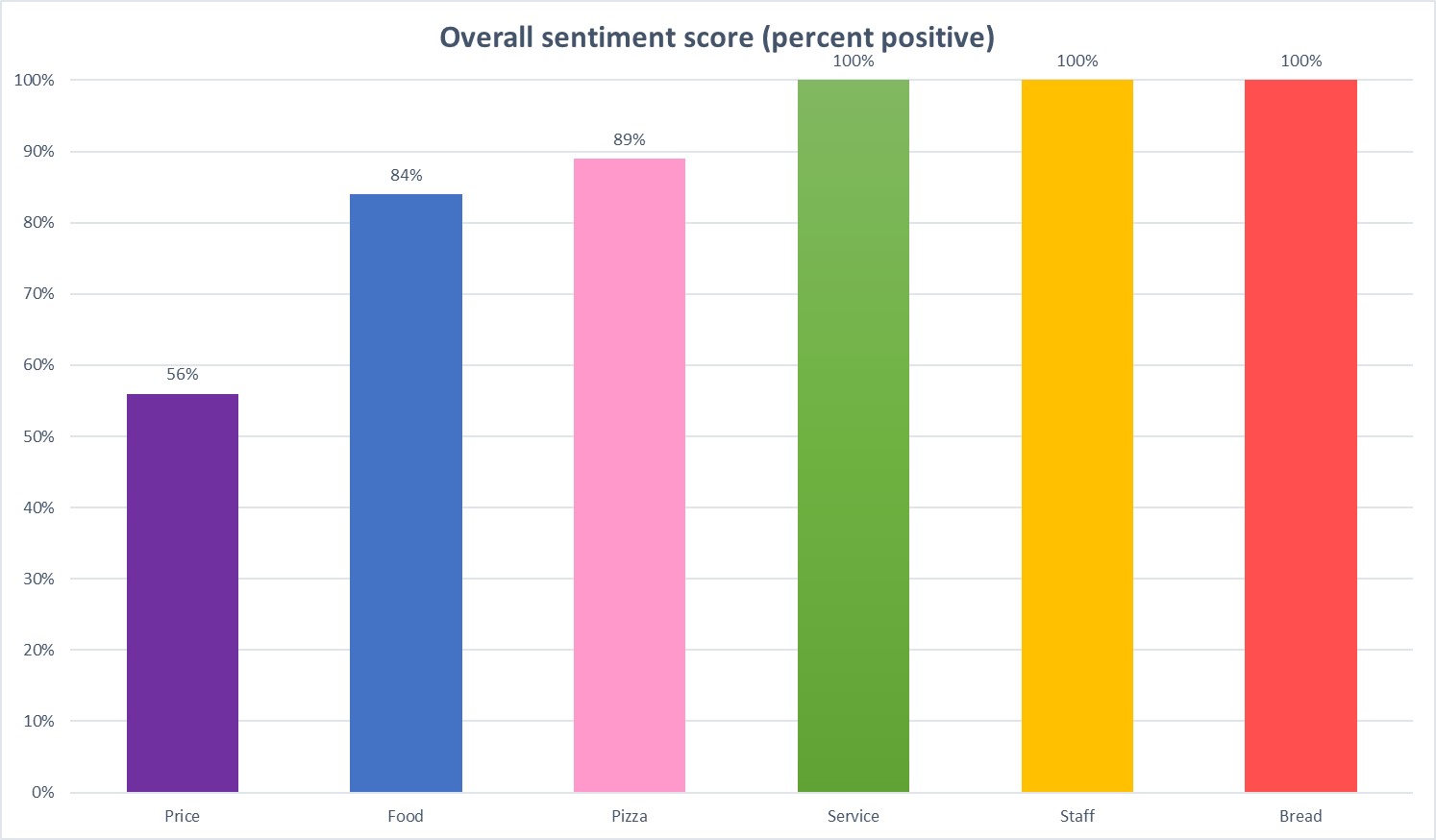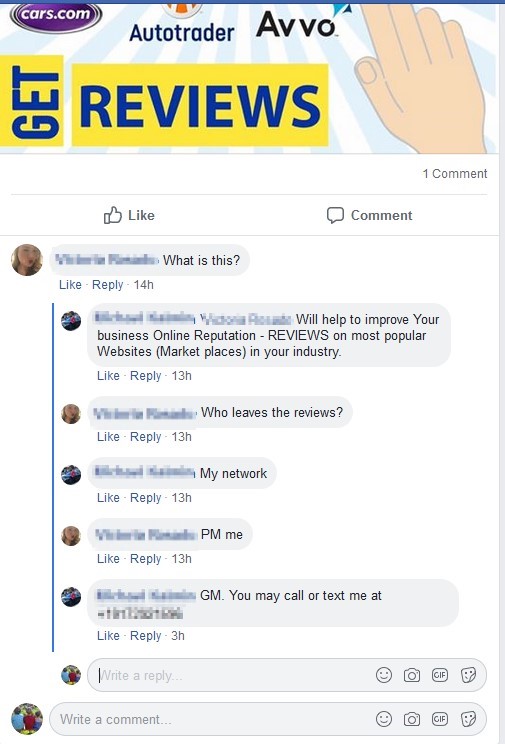Social media posts and reviews from review sites like Yelp are an important and powerful marketing and feedback tool for businesses. They are readily available on the Internet and provide customers’ opinions on different aspects of restaurants, car mechanics, cinemas, IT consulting firms, mobile apps, Internet hosting companies and every other kind of business out there. The data insights embedded in these customer messages are very informative, but are not readily available without further analysis.
Consider this review of Pomodoro, an Italian restaurant:
Don’t let the pizza parlor storefront or steep, narrow flight of stairs put you off, this place really knows how to do homemade Italian and the price is right! BYOB, not too crowded on a Friday night, great service, and very good food (special attention to the homemade pastas and sauces- pappardelle and black squid linguini were best). All in all, looking forward to returning!! [Emphasis mine]
The review talks about several topics: price, quality of food, and level of service. We can easily parse out those brief evaluations from this one particular review just by looking at it, but imagine trying to sieve through hundreds of such descriptions. It would take a very long time to discover the relevant topics and to analyze customer feedback on those topics manually.
Breaking down reviews by topic and assessing sentiment on them is easily done using NLP tools. The process involves the following steps:
- Collect reviews and social media mentions for a business, in this case, the Italian restaurant Pomodoro.
- Break reviews into parts (“this place really knows how to do homemade Italian”, “the price is right!”, “great service”, “very good food”, “looking forward to returning!”, etc.). Link the review parts with the complete reviews for more detailed analysis.
- Classify review parts into topics (price, service, food quality, etc.).
- Run sentiment analysis on each review part to determine whether it’s a positive or negative comment.
What you get from such an analysis:
- Clarity and efficiency: with all relevant review parts grouped by topic, there is no need to search and look through the reviews to see what customers think about each aspect of the business.
- Insights over time: if the analysis is run regularly, weekly or monthly, it is easy to see how the customer sentiment changes over time with respect to different aspects of the business. This gives business owners a very useful marketing and customer service tool that will quantify their efforts to improve their business.
Here is an illustration of how the complete review analysis works. For the restaurant above, I collected 76 reviews and ran them through the system. The discovered review topics were: service, staff, food, price, pizza and bread (apparently, bread is important enough that it is being talked about by many customers!). The scores were generally positive:

Here are some review snippet examples with corresponding positive or negative sentiment:
Service. Overall sentiment score: 100% positive
- positive “service was good”
- positive “service has always been good”
- positive “the service was great”
- positive “service was pretty decent!”
- positive “so service is really good”
Staff. Overall sentiment score: 100% positive
- positive “and friendly staff”
- positive “the staff in the kitchen are very nice people”
- positive “the staff is super friendly”
Food. Overall sentiment score: 84% positive
- positive “not only is the food amazing and always up to par”
- negative “2/5 because bad food”
- positive “the food here is amazing!”
- negative “the food was n’t great either.”
- positive “food is fresh and steaming hot.”
Price. Overall sentiment score: 56% positive
- positive “if you want quality for a decent price, Pomodoro is a way to go”
- negative “a price that is a bit high for what I got”
- positive “fresh homemade pizza for reasonable prices”
- positive “did my son’s birthday upstairs for a very reasonable price”
- negative “Although it’s a bit pricey”
Pizza. Overall sentiment score: 89% positive
- positive “the pizza was great”
- positive “we got the 16 ”abruzzo pizza and it was wonderful!”
- negative “we stopped bothering getting pizza there because it is a little more expensive than donnagio’s and not much better”
- positive “their pizza is probably one of the best in the area if you like the more thin crust pizza”
Bread. Overall sentiment score: 100% positive
- positive “their freshly baked bread was divine!”
- positive “the only good part was the bread”
- positive “the bread they bring out for free is amazing!”
Evidently, customers are mostly happy with this restaurant, except for the price. The business can use this bit of insight to justify their higher than average prices by describing, for example, their fresh ingredients in the marketing materials.
For the negative reviews, the analysis links the review parts with the complete reviews so the business owner can figure out the exact problem. For example, one negative comment about food was “2/5 because bad food”. Here is the complete review:
After wanting to test this place out for months I had the chance to do so. The experience wasn’t as good as I expected, in fact it was surprisingly disappointing. The outdoor seating looked great but I decided on the upstairs indoor area just to see what kind of restaurant this is. The decor was alright, nothing nice and nothing bad. The menu options seemed really good and I went with the waiters suggestion on chicken with potato in a cream sauce. The dish came with penne in red sauce as a side (which was better than the main). The main had rubbery chicken that had just about no flavor to it, the sauce was watered down so also lacked in the “cream” part of cream sauce. The pepper and potato wasn’t bad, but I didn’t order a 16$ plate of potatoes and green peppers. The worst and most surprising thing was the vibrating floor. It seems like my table was set over an industrial refrigerator. Trying to eat while my chair and table vibrated like a cellphone was not pleasant. 2/5 because bad food, bad dining experience and a price that is a bit high for what I got. Wood not recommend the food or eating indoors. Maybe try the pizza in the outdoor?
Thus, “rubbery chicken” and lack of cream in the cream sauce were the main problems that produced the bad food score. The business owners can use these insights to address any outstanding problems.
Are customer reviews reliable?
As recently as this month, I saw this post in one of the Facebook groups I belong to:

Writing dishonest reviews is a business, and filtering them out is a very important step in the review analysis. There are two ways of approaching fake review identification:
- Analyzing the text for unusual features. For example, comments that are extremely positive or extremely negative are suspicious. Also, the more the review mentions the brand being reviewed, the more likely it is that it’s a dishonest assessment, as that can be part of “keyword stuffing”: a search engine optimization strategy.
- Analyzing the behavior of the users who leave the reviews. Users that write the reviews “for hire” tend to write them in bursts, indicating ongoing marketing campaigns. Another characteristic is similarity of reviews posted: many reviews written by one fraudster will be semantically very similar, or even exactly the same.
The best fake review filtering systems combine the two approaches, reaching high levels of accuracy in detecting review spam.
NLP tools let us filter out suspicious comments, split up authentic customer reviews and social mentions by topic and do sentiment analysis on each topic separately, thus producing actionable insights and providing useful marketing tools for business owners.
If you need to have such a review analysis completed, please do not hesitate to contact us at info@practicallinguistics.com.
Consumer Choice is a product and service recommendation site that is scheduled to launch soon. We at Practical Linguistics did the review analysis engine for Consumer Choice.
Photo credits: Depositphotos/Aleksandr Filimonov

